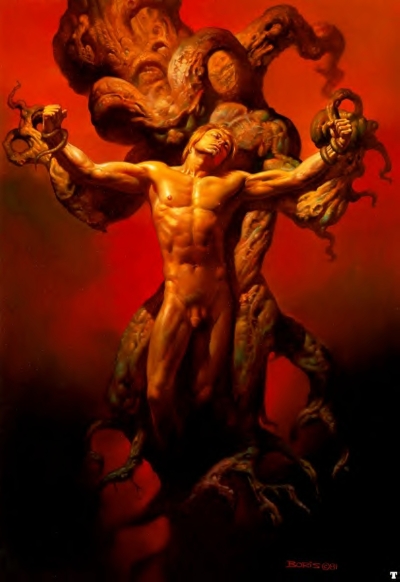For ever die, and ever buried bee
In balefull night, where all things are forgot;
All be he subject to mortalitie,
Yet is eterne in mutabilitie,
And by succession made perpetuall,
Transformed oft, and chaunged diverslie:
For him the Father of all formes they call;
Therefore needs mote he live, which living gives to all.— Edmund Spenser, The Faerie Queene
In The Golden Bough: A Study in Magic and Religion, James Frazer theorized that ancient peoples believed in a Dying and Reviving God, representing the animating spirit of vegetation, who was incarnated in human form as sacral kings, who were sacrificed after a term or when their power of mind or body failed, in a cyclical renewal of life. Frazer argued that many pagan gods were types of this Dying and Reviving God archetype, who died and rose again with the changing of the seasons and was responsible for the fertility of the crops on which humans depended.
“Under the names of Osiris, Tammuz, Adonis, and Attis, the peoples of Egypt and Western Asia represented the yearly decay and revival of life, especially vegetable life, which they personified as a god who annually died and rose again from the dead. In name and detail the rites varied from place to place: in substance they were the same.”
In the second edition of The Golden Bough, Frazer identified the Christ figure as an example of the Dying and Reviving God archetype.
Scholars have criticized Frazer’s theory, arguing that he glossed over significant differences in order to find his archetypal Dying and Reviving God. But regardless of whether ancient pagan gods fit the archetype, Frazer’s theory has had a profound influence on Neo-Paganism. Frazer was a significant influence on Jane Ellen Harrison, Robert Graves, Dion Fortune, and through them on Neo-Paganism.
Frazer’s myth of the Dying and Reviving God can be understood as a special type of Joseph Campbell’s Monomyth. According to religious studies scholar, Robert Puckett, Frazer’s theory of myth has now become a myth itself, or rather a “metamyth,” which has become permanently ingrained in the Western consciousness. The extent of the influence of James Frazer on Neo-Paganism can hardly be overstated.
This is ironic, because Frazer himself was an atheist, and one of his purposes in writing The Golden Bough was to discredit Christianity by suggesting that the figure of Christ had been an outgrowth of the pagan belief in a dying and reviving vegetation spirit. Frazer pointed to Osiris, Adonis, Tammuz, and other dying and reviving gods from myth to support his thesis. Frazer’s purpose was not to legitimate pagan religions. Nor did he intend to affirm the superiority of Christianity by arguing that the pagan precedents were devilish imitations or a “type” of Christ looking forward to the revelation of the divine reality. Rather, Frazer wanted to consign the whole field of religion, Christian and pagan, to the rubbish heap of history.
Ronald Hutton states that Frazer’s thesis “arguably did succeed in doing further damage to the status of Christianity, but it fostered not so much an enhanced respect for rationalism and progress as a delight in the primitive.” In the minds of Neo-Pagans, while Frazer succeeded in reducing Christianity to just another form of the religion of the Dying and Reviving God, he failed in his goal to undermine the validity of the pagan religions. The ironic effect of The Golden Bough was rather the creation of a Neo-Pagan religion, which was antagonistic to Frazer’s modernist agenda:
“[B]y placing Christ in a context of dying and resurrecting pagan deities, Frazer had hoped to discredit the whole package of religious ideas. Instead, as some of the literary use of the Bough indicates, he actually gave some solace to those disillusioned with traditional religion, by allowing them to conflate the figure of Jesus with the natural world.”
According to Sabina Magliocco, the group of classical scholars at Cambridge University, known as the “Cambridge Ritualists,” was inspired by Frazer to reconstruct …
“a set of rites synchronized to the seasonal cycle of planting and harvesting in which the king was killed, descended to the underworld, fought against the force of darkness, then resurrected to celebrate a divine marriage with the temple priestess/sacred concubine.”
Theodor Gaster, for example, interpreted the motif of the Dying and Reviving God as underlying many seasonal rituals. Drawing on the Canaanite myth of Ba’al, Gaster outlined four stages in the life-cycle of the Dying God, which corresponded to four universal seasonal celebrations:
- Mortification: a state of suspended animation at the end of the year, when one lease on life has drawn to a close and the next is not yet assured
- Purgation: a ridding of evil influences that might impair prosperity in the coming year and threaten the renewal of vitality
- Invigoration: a galvanizing of the moribund condition to procure a new lease on life, which commonly takes the form of a ritual combat between life and death, summer and winter, or the old and the new years
- Jubilation: a sense of relief when the new year has begun and the continuance of life is assured
Likewise, Gilbert Murray theorized that the ritual form underlying Greek tragedy followed a similar pattern:
- Threnos: a lamentation of the death of the year-god
- Theophany or Peripeteia: a resurrection and epiphany of the year-god, which is accompanied by a change from grief to joy
- Agon: a contest of the year-god against his enemy, light against darkness, or summer against winter
- Pathos: a ritual or sacrificial death of the year-god, followed by an announcement of the same by a messenger
These roughly correspond to the four seasons (in temperate climates), from autumn to summer. The outline produced by these theorists became the foundation of the modern Neo-Pagan Wheel of the Year with its eight-fold division of the ritual year, with its solstices and equinoxes and seasonal quarter days.
Updated 2019
